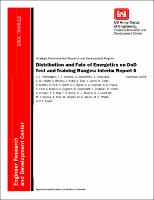Please use this identifier to cite or link to this item:
https://hdl.handle.net/11681/8493| Title: | Distribution and fate of energetics on DoD test and training ranges : interim report 6 |
| Authors: | Defence Research Establishment Valcartier Institut national de la recherche scientifique (Québec) SpecPro, Inc. Envirostate (Firm) Naval Explosive Ordnance Disposal Technology Center (U.S.) United States. Army. Redstone Technical Test Center AMEC Earth and Environmental Cold Regions Research and Engineering Laboratory (U.S.) Strategic Environmental Research and Development Program (U.S.) Pennington, Judith C. Jenkins, Thomas F. Ampleman, Guy, 1954- Thiboutot, Sonia, 1962- Hewitt, Alan D. (Alan Dole) Brochu, Sylvie Robb, Joseph Diaz, Emmanuela Colby, Herb Martel, Richard Poe, Ken Groff, Kimberly Bjella, Kevin L. Ramsey, Charles A. Hayes, Charolett A. Yost, Sally L. Marois, André, 1959- Gagnon, Annie Silverblatt, Bryan Crutcher, Thomas A. Harriz, J. Kimberly Heisen, Karilyn Bigl, Susan R. Berry, Thomas E. Muzzin, Joanne Lambert, Dennis J. Bishop, Michael J. Wojtas, Marie Walsh, Marianne E. Walsh, Michael R. Taylor, Susan Lewis, Jeff Rice, Benjamin |
| Keywords: | Anti-tank ranges Battleruns Blow-in-place Detonation residues Explosives Munitions Fate and transport of explosives High-order detonations HMX Low-order detonations Propellants RDX Test ranges TNT Training ranges Firing ranges Military installations Soil pollution Groundwater Environmental management |
| Publisher: | Environmental Laboratory (U.S.) Engineer Research and Development Center (U.S.) |
| Series/Report no.: | ERDC TR ; 06-12 rept. 6. |
| Description: | Technical Report Abstract: Understanding the potential for generation and transport of residual explosives is necessary to sustain live-fire training ranges. The objective of this study was to characterize the distribution and fate of explosive residues from various training activities. The physical and chemical properties, concentrations, and distribution of residues in soils, and the potential for transport to groundwater were defined. Surface soils associated with impact craters, target areas, and firing points on U.S. and Canadian ranges were characterized. Residues from high-order, low-order, and blow-in-place detonations were described and quantified. Parameters suitable for use in fate and transport models and environmental risk assessments were determined for constituents of concern. Results demonstrated that residues are specific to range activities. Demolition areas, low-order detonations sites, and firing positions have great potential for accumulation of residues. Demolition typically generates small areas of relatively high concentrations. Low-order detonations generate primarily large solid particles reflecting the composition of the predetonation explosive. Artillery and mortar impact areas tend to have low concentrations of widely distributed constituents. Firing positions may exhibit high concentrations of propellants. Results of this study provide a realistic evaluation of training range residues and a scientific basis for development of control measures for explosives residues. |
| Rights: | Approved for public release; distribution is unlimited. |
| URI: | http://hdl.handle.net/11681/8493 |
| Appears in Collections: | Technical Report |
